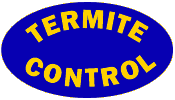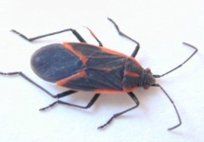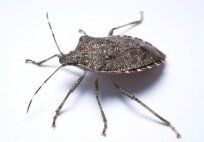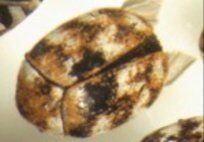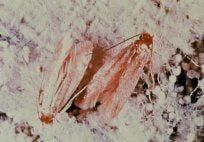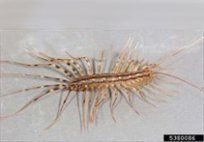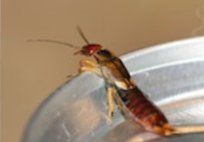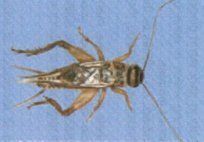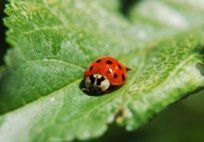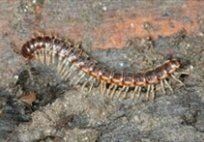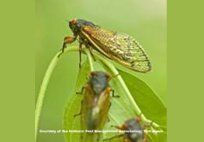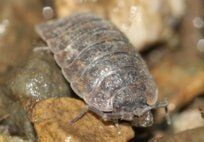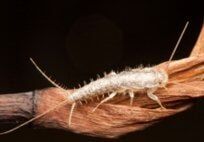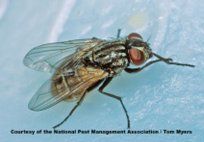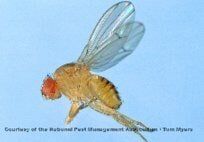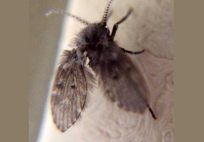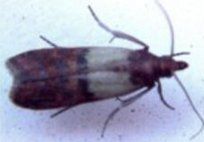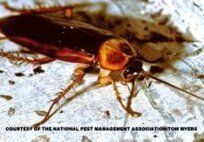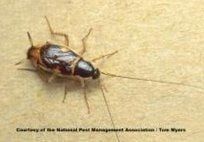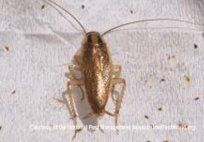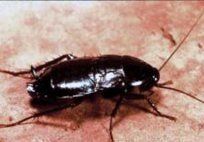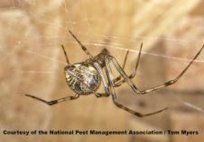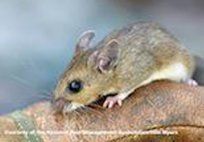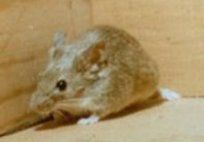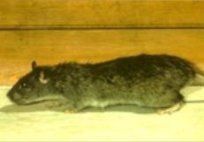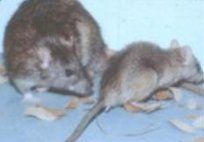OCCASIONAL INVADERS
Boxelder Bug
Boxelder bugs get their common name from the fact that they are often found on and around boxelder trees. They live and thrive on maple and seed-bearing boxelder trees during the warmer months where they lay their eggs and feed on leaves, flowers and seeds. In autumn, boxelder bugs will congregate on the south side of buildings where the sun hits. They will migrate to nearby buildings or homes to overwinter, hiding in small cracks and crevices to insulate themselves from the colder winter temperatures. In late March to early April, adults leave their overwintering sites to return to their host trees for the warmer months.
Color: Black with reddish or orange markings on dorsum
Legs: 6
Shape: Elongate-oval, somewhat flattened with head narrower than pronotum
Size: 1/2” (11-14 mm)
Antennae: Yes
Stink Bugs
Brown marmorated stink bugs are an invasive species from Asia that arrived in Pennsylvania around 1996. The stink bug earned its name from its tendency to release an odor when disturbed or when crushed. The adult stink bugs will feed on fruits and will seek overwintering sites in late fall from the colder temperatures.
Color: Mottled grayish-brown
Legs: 6
Shape: Triangular or shield
Size: 3/4" long
Antennae: Yes
Carpet Beetle
Varied carpet beetles get their name from the rainbow of color on their back surfaces. These pests enjoy dining on a variety of upholsteries, carpets and clothing fabrics. Storing clothing in plastic containers and dry cleaning the clothing thoroughly before storing for long periods of time will greatly reduce the chances of infestations.
Color: Black centers, with white, brown and yellow patches in an irregular arrangement
Legs: 6
Shape: Round
Size: 1/16
Antennae: Yes
Clothing Webbed Moth
The larva is the damaging stage of the clothing webbed moth. They will typically feed on any type of wool clothing, carpets, upholstered furniture, as well as furs. They will also feed on synthetics or cotton blends if these fabrics also contain wool.
Color: Wings and body are golden in color with reddish hair on top of its head
Legs: 6
Shape: Elongated oval
Size: ¼ “ long
Antennae: Yes
FLIES
House Flies
House flies get their name from being the most common fly found around homes. Adult house flies can grow to one-quarter of an inch long and usually live between 15 and 25 days. These insects have been known to carry over 100 different kinds of disease-causing germs. They are only able to feed on liquids but have the ability to turn many solid foods into a liquid for them to eat. Sanitation and removal of trash will go a long way in preventing these pests from getting out of control.
Color: Dark gray
Legs: 6
Shape: Small oval
Size: 1/4 of an inch
Antennae: Yes
Fruit Flies
Fruit flies get their common name from their small size and fondness of some fruits. They are found on moist, decaying matter that has been stationary for several days. Small fruit flies are nuisance pests, but may act as disease vectors.
Color: Tan/ light abdomen
Legs: 6
Shape: Small oval
Size: 1/8 of an inch
Antennae: Yes
Drain Flies
Moth flies, also known as drain flies, develop in gelatinous film and decaying organic matter often found lining drain pipes and traps, and garbage containers.
Color: Yellow to brown /black
Legs: Six
Shape: Cylindrical
Size: less than ¼”
Antennae: Yes
Indian Meal Moths
The Indian meal moth was given its name after an insect scientist found it feeding on corn meal. From wing tip to wing tip, adult moths measure from five-eighths of an inch to three-fourths of an inch long. They can contaminate food products by feeding on dried fruits, grains, seeds, nuts, chocolate, candies, bird seed, dog food, powdered milk, dried red peppers and candy. Any infested items should be thrown away. Storing food in sealed containers will help to reduce the chances of infestations.
Color: Copper reddish coloring on outer part of wings
Legs: 6
Shape: Elongated oval
Size: 5/8"
Antennae: Yes
ROACHES
American Cockroach
The American cockroach is the largest of the house-infesting cockroaches. American roaches have been reported to spread at least 33 kinds of bacteria, six kinds of parasitic worms and at least seven other kinds of human pathogens. They can pick up germs on the spines of their legs and bodies as they crawl through decaying matter or sewage and then carry these into food or onto food surfaces. Recent medical studies have shown that cockroach allergens cause allergies and exacerbate asthma attacks, especially in children. They typically enter structures through drains and pipes. Practicing good sanitation goes a long way in preventing these pests from infesting a location.
Color: Reddish-brown, with a yellowish figure 8 pattern on the back of the head
Legs: 6
Shape: Oval
Size: 2" long
Antennae: Yes
Brown-Banded Cockroach
Brown-banded cockroaches get their name from the two lighter bands they have across their dark brownish bodies. Brown-banded cockroaches often hide their egg cases in or under furniture. They tend to prefer higher locations than most cockroach species and are often found in upper cabinets in kitchens and bathrooms. They can live for about 206 days and as with other species of roaches, they can pose a threat to individuals with allergies.
Color: Brown, with pronounced banding across wings
Legs: 6
Shape: Oval
Size: 1/2" long
Antennae: Yes
German Cockroach
The German cockroach is the most common species of the cockroach. German cockroaches can breed at a rate of up to six generations per year. The German cockroach can fit through an opening as small as 3/8 inch in width. They will feed on almost anything and are excellent hitchhikers often finding their way into new structures via grocery bags, cardboard boxes and secondhand appliances. As with many other species of roaches, the German cockroach has been implicated in outbreaks of illness and allergic reactions in many people.
Color: Light brown to tan, with two dark, almost parallel stripes located on their backs, just behind their heads
Legs: 6
Shape: Oval
Size: ½”-5/8” long
Antennae: Yes
Oriental Cockroach
Oriental roaches are sometimes called “waterbugs” because they come out of drains. They are known for their strong, unpleasant, “roachy” odor. Orientals will feed on all kinds of food, especially decaying organic matter and starchy foods. They are found in many of the same places other roach species are found. Practicing good sanitation, sealing entrances, reducing moisture, keeping a clean kitchen, and sealing up any openings around pipes will help to prevent infestations.
Color: Shiny black
Legs: 6
Shape: Oval
Size: 1" long
Antennae: Yes
SPIDERS
House Spider
The common house spider is usually the spider most often encountered indoors. It is a nuisance pest, probably more because of its webs than the spider itself. This spider randomly selects its web locations and creates a tangled web. If it's web does not yield prey it is abandoned, another site is selected, and a new web is built. You will often find these webs near light sources, where the webs are more apt to catch prey attracted to the light.
Color: Yellowish brown, abdomen dirty white with several dark stripes meeting at angle
Legs: 8
Shape: Elongated abdomen
Size: 3/16 – 5/16“ (female) 1/8 – 3/16” (male)
Antennae: No
Long-Bodied Cellar Spider
Long-bodied cellar spiders are commonly referred to as "daddy-long-legs". This is because of their very long, thin legs, and the fact that they are found in dark and damp places like cellars and basements.
Color: Pale yellow to light brown or gray
Legs: 8
Shape: Long skinny legs with a small body
Size: ¼-3/8” (6-9mm)
Antennae: No
RODENTS
Deer Mouse
The deer mouse is found in rural areas and rarely invades residential homes. Deer mice are of medical concern because they are common carriers of Hantavirus. This disease can be transmitted through contact with mouse carcasses, or by breathing in aerosolized urine droplets of infected deer mice. Sealing openings around the home will prevent these mice from gaining entrance as they can squeeze through spaces as small as a dime.
Color: Brown, with white feet and underbelly
Legs: 4
Shape: Round
Size: 5 to 8 inches long
House Mouse
The house mouse is the most common rodent in homes. It can breed rapidly and adapt quickly to changing conditions. In fact, a female house mouse can give birth to a half dozen babies every three weeks, and can produce up to 35 young per year. They prefer to eat seeds and insects, but will eat almost any kind of food. House mice are excellent climbers and can jump up to a foot high; however, they are color blind and cannot see clearly beyond six inches. Mice can present many problems from physical damage to property to bringing in additional pests with them such as fleas, mites, ticks and lice. The micro droplets of their urine can also cause allergies in children.
Color: Dusty gray with a cream belly
Legs: 4
Shape: Round
Size: 2 1/2 - 3 3/4" long


